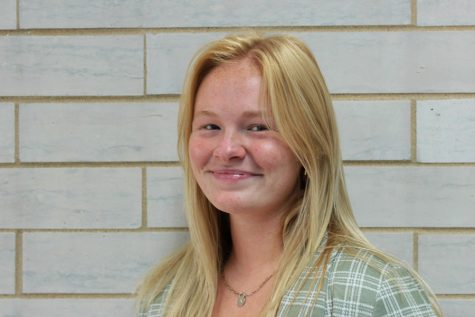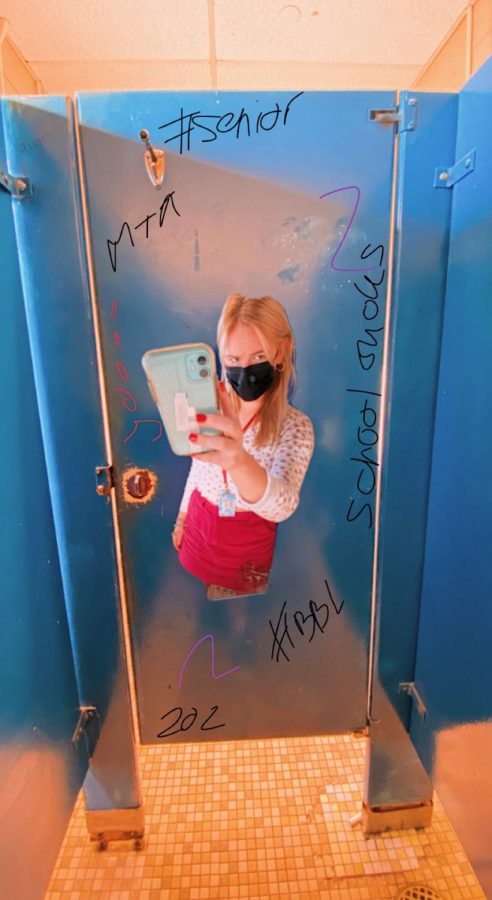The muck after all the buck
A bathroom stall filled with words that actually appear in stalls at the school.
Can I interest you in a bathroom door that doesn’t close? Or if not how about a sink that takes six pumps to get a little freezing cold water out of? How about a jammed paper towel machine?
Well, it’s what you’ll get anyways, and do please read the sign above that teaches you the proper way to wash. It’s important to be clean.
The bathrooms here in the south have no business being as dirty as they are. DGS spent thousands of dollars on new renovations and none of it went towards bathroom improvements, and don’t get me started on those bathroom paint jobs.
The bathroom doesn’t have to be china glass and squeaky clean but pleases at least a working sink and a door that shuts is all we ask. The girls’ locker room for the main gym gives just about the clearest representation of this.
Doors that sway right open, locks that don’t work, and doors that, when shut, don’t open. I mean really, they’ll stick there once they are shut. We are expected to be on the court in 10 minutes dressed and warming up, but I and three other girls are committing our warm-up to a bathroom door.
Senior athlete Brooke Patton shared her take on what it’s like to experience the stress of the bathrooms from day today.
“The bathrooms in the girl’s locker room are by far the worst when it comes to the problem. The doors won’t fully close unless the one right next to it is pushing it into place, or you can hardly open the doors because when they’re all closed at once they get jammed,” Patton said.
It goes to show that the students can verify that there’s a need for more than just a clean-up, but a security check-in so that students feel like they can use those bathrooms.
“Obviously it’s not the end of the world, but you do feel really uncomfortable in there because you never know if the person opening their stall next to you is going to make yours fly open,” Patton said.
Before you assume that the standpoint comes from just dramatic teenagers, there’s the staff that agrees that their bathrooms to aren’t the most welcoming.
English teacher Lauren Mcsweeney shared her opinions on these bathrooms as well.
“For the many years I have worked here, I have only known the restrooms [especially staff ones] to be pretty tattered and unappealing,” Mcsweeney said.
Now with the school’s new renovations, it’s hard to swallow the idea that more than half the bathrooms stayed untouched.
“I understood most of the time because it is an old building, but now that there are renovations it is hard to swallow that I still can’t have a working paper towel dispenser to dry my hands after washing them,” Mcsweeney said.
It’s clear that the bathrooms were not and still are not a priority here at south; for many reasons, that should be changed. Kids’ safety and public health coming from a year’s worth of no school in-person should signal the school to be more careful than ever.
“I don’t know the financial situation and it is not my job to make those decisions about what needs updating or where the money should go. If I were to fight for that to be something that gets taken care of if/when we can, I would say it is an essential need for staff and students that the restrooms are more than mostly functional, but also that they feel comfortable, safe, and clean throughout the day, especially after the pandemic,” Mcsweeney said.
Now I’ve really painted the picture out to be bad for our school’s bathrooms but in reality, it’s the world we live in.
Elissa Gootman writer for the New York Times shares bathrooms is avoided like the plague.
“At Abraham Lincoln High School in Brooklyn, the bathrooms are so bad that students have been known to use the toilets at Coney Island Hospital, down the road. At the High School for Health Professions and Human Services in Manhattan, leaky bathroom ceilings prompt students to head for McDonald’s or hold out for hours.” Gootman says.
Given a similar financial advantage as our school, Abraham Lincoln High School is handed money to make changes. Money here has been given for bathrooms specifically and nothings come of it for these students it seems almost they completely dropped their urge to fix them.
“Education officials agreed that some bathrooms are below par and noted that the mayor’s proposed $13.1 billion five-year capital plan for education includes more than $29 million for bathroom renovations. But the plan relies on billions on extra dollars from the state budget.” Gootman says.
The New York times again proposes yet another idea of the dangers in public restrooms, yet this time one of the DGS’sbiggest weaknesses. The sinks and how we get them to work.
Like I mentioned before the sinks take a few pumps and by then your dirty hands have now touched the sink for the next person to capture all that goodness you left for them, sharing is not caring here.
The New York Times mentions In their article “How to wash your hands” by Tara Parker, that by touching any part of a sink in a public restroom you’ve now rubbed more germs on you gaining more than what you’ve started with.
The bathroom functionality may just be way more important than we thought, all around the globe.
As messy as this situation sounds, it’s clear there’s room for some squeaky clean improvements to be made. The school staff, students, and maintenance must take into account both awareness of public health and personal as well.
In order to keep things clean, sly, and safe from the spreading of germs there are many more solutions that don’t involve a sink that takes more effort to turn on than to wash with or a door that stays open. Please DGS, this isn’t a Pottery Barn Teen; we don’t take things like doors and hang them up for decoration. It’s a public bathroom, not a 15-year-old’s DIY YouTube account.
We need to encounter more serious beliefs in the idea that our health comes first and that starts with taking care of business, all kinds of it. That business needs to be kept clean as always, we can be better if we knew better.


